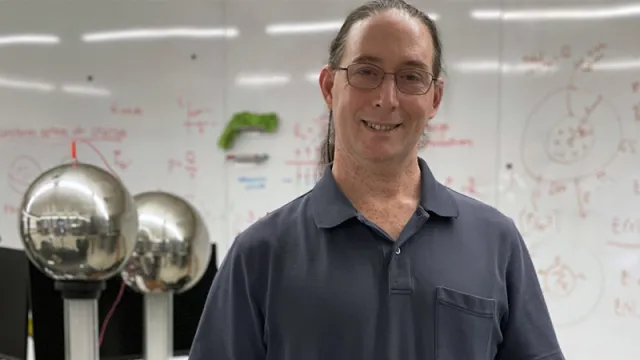A ‘Sea Change’ in the Sciences
Research & Inquiry
With the help of an alum, higher ed physics departments—including Smith’s—are taking a hard look at diversity, equity and inclusion

Published February 27, 2023
A relatively new pilot program of the American Association for the Advancement of Science (AAAS)—known as SEA (STEMM Equity Achievement) Change—encourages colleges and universities to consider systemic and structural adjustments regarding equity, diversity, and inclusion from an institutional perspective.
However, Alexis V. Knaub ’06, Physics and Astronomy (P&A) SEA Change project manager for the American Association of Physics Teachers (AAPT), believes some of the most consequential and transformative work can be accomplished at the departmental level.
Through training and other resources, the P&A SEA Change program enables P&A departments to use data to help pinpoint where they are, what they’re doing well, and where they can improve in regard to equity, diversity, and inclusion.
Still in its pilot phase, the program, which launched in 2020, is a partnership among a number of professional P&A organizations led by the AAPT. (The pilot program was funded by the American Institute of Physics.)
Smith is one of only 11 institutions nationwide participating in the first two cohorts of P&A departments, reflecting Smith’s commitment to ensuring that the sciences are more representative and welcoming to traditionally marginalized communities.
At the core of the P&A SEA Change process is a rigorous self-assessment that covers every aspect of a department’s policies, procedures, and perceptions regarding staff, faculty, students, and coursework. “The self-assessment enables people to take a deep dive into their department and reflect on the information they’ve gathered,” says Knaub, who was a physics major and theatre minor at Smith and holds graduate degrees in physics and physics education.
The program emphasizes quantifiable change and asks participants to create action plans that reflect the acronym “SMART”: specific, measurable, actionable, relevant, and timely. “Whatever you decide your action plan's going to be needs to be supported by whatever you find out,” Knaub says. “It needs to be grounded in your self-assessment data, and it needs to be something you can do within five years, so you can make measurable progress.” When a department presents a doable action plan that’s well supported by its self-assessment, it receives a bronze award that is valid for five years. “If all goes well, we will grant the first departmental awards this year,” says Knaub.
Professor of Physics Gary Felder was eager to be part of P&A SEA Change’s first cohort. “The physics department is deeply committed to equity and inclusion, and we think of it as one of our highest priorities as a department,” he says. “None of us has expertise in this area, and I think that lack of expertise or training can easily become an excuse for inaction. I think it’s not uncommon for faculty members to say, ‘That's not the kind of thing I know how to do,’ and wash their hands of it. We have no interest in doing that; we want to educate ourselves.”

Physics professor Gary Feldman was eager for Smith to be part of the new P&A SEA Change program in the sciences.
One of the challenges for all the departments in the first cohort, Felder says, was to learn how to obtain meaningful, anonymous data, considering that most physics departments tend to be much smaller than other STEM departments like chemistry or biology. “At this point, we have four tenure-track faculty, three lecturers, and one lab supervisor,” Felder says. “We can’t meaningfully survey any of these groups. We can talk about anecdotal data, we can talk about some demographic data, but we didn’t know how to get statistics.”
To help, the P&A SEA Change Committee led regular virtual meetings with departments. “We were all going through this process,” Felder says, “and we learned from each other.” Eventually, with assistance from Smith’s Office of Institutional Research and the Office of Equity, Inclusion, and Diversity, Felder and his group administered a survey to all Smith students who had taken at least one physics class. Anecdotal data was used for staff and faculty.
One issue the Smith data indicated was that while students from all demographic groups found the physics department to be mostly welcoming, a significant number of underrepresented groups and first-generation students felt unsupported because they were not prepared academically. Another issue, historically, with physics/astronomy departments has been a lack of gender diversity. But Smith appears to be leading in this area. “At Smith, we graduate eight to 10 physics majors per year (most who identify as women), which is an order of magnitude higher than the national average in attracting women to physics,” says Felder. “I think that has a lot to do with the tremendous effort that the faculty puts into creating a sense of belonging for students in the department.”
The Smith physics department action plan has not yet been made public, but Felder says it is quite lengthy and includes a range of action items, including highlighting the contributions of physicists of color and women physicists and hiring faculty of color.
In the future, Knaub hopes that there will be funds attached to the awards. Also, there is the possibility that departments go through another self-assessment after five years and create a second action plan to build on the changes of the previous five years.
“I hope this process will result in more equitable and inclusive physics and astronomy departments and higher ed institutions,” Knaub says. “Some things can only be changed at the institutional level, while other decisions are on a departmental level. The goal is for both the institution and departments to better understand their organizations through self-assessments and collaborative work to create lasting change.”
Alexis Knaub ’06 is project manager for a new diversity program in the sciences.